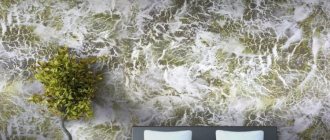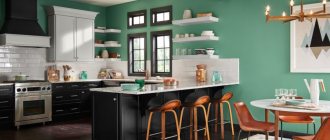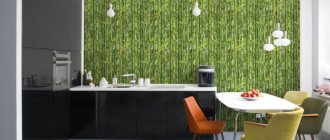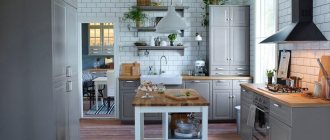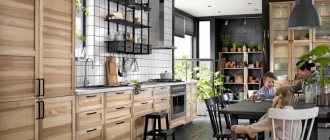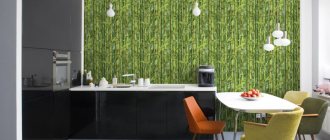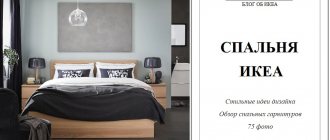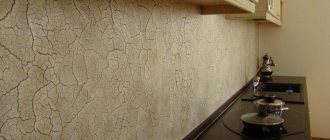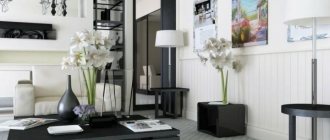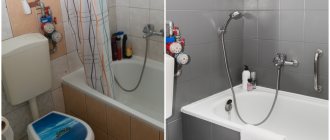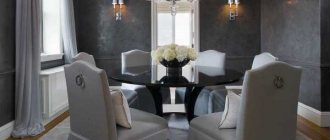Decorative plaster in the kitchen has become a high-quality and stylish alternative to wallpaper decor.
Before you decide to decorate your walls with plaster, you should seek the opinion of a specialist. Despite their durability and promising cost-effectiveness, the compositions themselves are not a cheap pleasure. A thoughtful approach will help you avoid unnecessary expenses.
Decorative plaster - what is it?
Decorative plaster is a special mass that allows you to create selected patterns and textures on the wall surface.
These can be abstract patterns, traditional “sheep” patterns or trendy effects inspired by materials such as concrete, stone or wood. Another way to achieve a stunning effect is to use structural or decorative acrylic paints.
What are the advantages of this plaster? Thanks to its thickness, it will help to visually compensate for any unevenness in the wall, so its surface does not have to be perfectly smooth.
- It can usually be applied to different types of substrates: brick, concrete, cement-lime plaster, as well as gypsum boards, gypsum bases and wood boards.
- Such a base requires the same preparation as before painting or laying wallpaper - the wall should be cleaned of old coatings and, if necessary, degreased. Deep cavities should be filled with putty or primer plaster and painted with primer paint to ensure a smooth surface.
Decorative plasters are a wide range of products that have one thing in common: they allow you to give walls a unique look. Its nature will depend not only on the type of product used, but also on the technique of its application.
Decorative plaster fits perfectly into modern or classic interiors, being an interesting solution in monochrome spaces.
Although it can cover all the walls in the interior, it is perfect as a contrasting accent for surfaces painted with traditional paint. We can give them different shades and use them on different types of surfaces.
The best photos of real examples
In order to choose the most beautiful plastering, look at examples of real photos in the interior:
How do you like the article?
Performance characteristics of decorative plaster
Decorative finishing material is a special composition that differs from those analogues used for simple leveling. Its peculiarity is that the product is used for the final stage of surface finishing. Particles of marble, sand, granite, and quartz are added to it. There are also antiseptic additives, which prevents the development of harmful microorganisms. At the same time, there is not a single dangerous or toxic substance here. In other words, the material is clean from an environmental point of view.
Decorative plaster provides the coating with sound insulation and fire resistance. The applied mixture also receives other qualities:
- ability to withstand temperature changes;
- resistance to moisture;
- absorption of kitchen odors is eliminated;
- walls can be easily cleaned with detergents;
- the surface is not afraid of exposure to grease, water, dust;
- resistance to mechanical damage;
- exposure to sunlight does not have a harmful effect;
- the decorative appearance is preserved for a long period of operation.
Type of decorative plaster in the kitchen
Decorative cladding is universal in nature due to the fact that it adheres well to any wall made of different materials:
- concrete;
- bricks;
- drywall;
- wood;
- metal
To plaster walls with this finish, it is not necessary to have specific knowledge and skills. The mixture itself is supplied to markets in convenient packaging containers. Irregularities on the walls are masked, becoming invisible. And after applying the decorative mixture, joints and seams will completely disappear.
Advice! Picturesque mixtures can make the kitchen come alive against the backdrop of imitation of different directions - from natural stone to delicate silk flakes.
Selection of plaster
Finishing the walls with decorative plaster gives the interior a unique and original touch. However, to obtain the desired effect, it is advisable to choose the right texture.
Mineral
Mineral - most often used in the kitchen and bathroom
It is based on cement and is sold in powder form. Endowed with excellent resistance to moisture, suitable for any surface. Can be used in the kitchen and bathroom.
Under the skin
An effective, but also complex technique that may not suit every interior. Therefore, you need advice from a qualified specialist. Only a master should apply the plaster, otherwise the desired result will not be achieved.
Silicone
Silicone - fits easily on any surface
This is a ready-to-use mixture and does not need to be diluted. fits well and easily on absolutely any surface, be it wallpaper under plaster, old uneven walls or brick. It has good moisture resistance, suitable for corridors, halls, bathrooms or kitchens. It can be used even on unprepared surfaces.
Mosaic
The appearance of single-color walls with small specks is mosaic decorative plaster. There are mixtures with different particle sizes and different colors. It is used to decorate walls both outside buildings, houses, and indoors. The surfaces are smooth and easy to clean. They are resistant to chips, scratches, and impacts from heavy objects. This plaster fits perfectly on almost any surface - concrete, brick, standard plaster, plasterboard panel material. Another plus is good ventilation.
Stone chips
Stone chips are a cladding method that also deserves attention
I believe that this method of cladding also deserves attention. Stone chips from fine to medium fraction (0.5-5 mm) in a special binder can work wonders. The manufacturer can use marble, granite or quartz as the base (stones). This coating can be stylishly finished:
- arched openings;
- corners;
- niches;
- architectural elements.
The clear, cold appearance of the coating in combination with another type looks simply gorgeous.
Velvet and silk walls reflecting particles of light flows look elegant and rich.
- Graphite is very often used by both designers and users. This type of plaster allows you to create the texture of aged walls or applications. The living room will also look good in certain areas.
- Africa is a widely known type of decorative plaster with a texture reminiscent of crocodile or snakeskin. It will look good and appropriate in an ethnic style living room. This finish looks expensive, especially if it is topped with a layer of glitter, varnish or wax.
- Rustic with the texture of shabby stone is used in the design of living rooms created in a country or historical style.
- Your living room will only benefit if you decorate the ceiling with patterns and combine walls with decorative plaster with areas covered with wallpaper for painting.
- You can artificially age walls using craquelure or bark beetle plaster. Cracks and abrasions are relevant in classic and retro styles.
Flock
Flocks are made from small plates (flocks). They have different shapes and colors. You can get gloss or matte. Some solutions may emit a glow. Therefore, they are used in interiors of different styles.
Art concrete
Art concrete is a modern finishing material for walls, ceilings and floors. The mixture contains dry cement and gypsum powder. Various additives, fillers, dyes, and varnishes are also added to them. Soft plasters allow you to create original imitations of a concrete surface. They are decorated with rivets, pipes (especially in the loft style), images of slabs, stacked blocks (ideal for high-tech or minimalism styles).
Bark beetle with imitation of ancient walls
Antique finishing is suitable for Provence, country, shabby chic, Mediterranean design, loft and classic.
The “bark beetle” coating resembles wood eaten by bark beetles. You can choose a composition with different contents. The different distribution of the mixture produces deep or weak grooves.
Silk
Plaster to which mother-of-pearl is added looks like silk-screen printing on the wall. Texture here is achieved by adding small grains of stone chips or cellulose fibers. Silk plaster has earned high marks for decorativeness due to the delicate tints of the finished coating. Glare appears depending on the viewing angle where natural or artificial light falls. Silk plaster is ideal for the living room, bedroom, library, study, any room where there is a lot of upholstered furniture.
Textured
This is a material with a very viscous structure. The composition includes various fillers, such as mica, wood, granite or marble chips. Can be used for both internal and external work. Concrete, brick and even wooden bases are subject to finishing.
Advantages:
- formation of a durable waterproof but breathable coating;
- the ability to imitate other materials, such as leather, stone or wood;
- selection of decorative plaster color by tinting;
- excellent heat and sound insulation properties;
- ease of application and affordable price.
To create the desired pattern, you need to prepare a roller with a spatula and arm yourself with a stencil.
Marble
Marbled plaster can be smooth or streaked. The color palette allows you to create a resemblance to natural stone.
Sea breeze
- wave effect;
- translucent type of coating.
To obtain the desired effect, fine-grained sand is added to the solution. The result is a convincing imitation of the sea surface on the wall. The photo shows several examples of the use of such plaster in a residential area.
Brickwork
The optimal solution, which costs significantly less than the brick blocks themselves. Fans of Provence, Scandinavian style, and loft will appreciate this material, which allows you to create an imitation of a brick wall
All these types of decorative plaster allow you to create a special atmosphere in the kitchen, which will have a beneficial effect on the cooking process. It all depends on the preferences of who will “reign” in this room.
Use in the hallway
The corridor, hallway, and hall are considered, if not the main ones, then at least important in the house. They are called a showcase that introduces guests to the apartment, style tastes and preferences of the owners. Therefore, it must be formalized with dignity and correctly. This is how guests form their first impression.
Use of material in the hallway
- Smooth, patterned surfaces that subtly cover the walls are best for a small hallway.
- To visually enlarge the space, it is better to take as a basis decorative plaster of light colors with a smooth or finely granulated texture and a discreet design or pattern in the center.
- Any relief visually creates volume, so a small area of the room will be hidden.
- In combination with the Venetian, you can use gold-colored stucco, however, if this does not contradict the style of the project.
- For large hallways and halls, I recommend choosing Venetian. This way your space will sparkle in a new way, it will look not like an ordinary room, but like a real palace or a main entrance.
- Plaster that imitates brickwork or decorative stone looks gorgeous in the corridors.
- For interiors in the pop art style, three-dimensional drawings made in bright colors are best suited.
- Picturesque paintings, against the backdrop of decorative plaster, will complement the image and add elegance to the classic style.
- The delicate colors of textured plaster walls are the best way to enliven a Provencal-style hallway.
- The Venetian with the effect of wet silk looks gorgeous in the interior of the corridor. It can be safely combined with glass, wood or metal.
Corridors and hallways are deprived of a source of natural light, so they need to use a light palette and bright colors. It would also be correct to use mirrors in them, especially if they have a small usable area.
Natural, muted tones will help create an atmosphere of peace and tranquility in living rooms and corridors.
DIY decorative plaster in the kitchen
Not everyone can apply decorative plaster to a wall.
If you have a limited budget for kitchen renovations, you can decorate the walls with decorative plaster yourself. First you need to carefully prepare the base, remove old wallpaper or paint, and repair large cracks. The wall must be dry, level and clean.
The following stages of work:
- After the putty has dried, apply an acrylic primer.
- Allow the primer to dry and begin tinting, preparing and applying the plaster mixture. The applied decorative plaster is not painted; the pigment is added to the solution during mixing.
- A stainless steel spatula, roller, trowel, and sponge help to give the coating the required relief.
- After applying the plaster, the surface is covered with a special varnish, which forms an additional protective layer.
The work must be carried out by one person in order to maintain uniformity of texture throughout the entire wall.
Not every finishing material is suitable for decorating kitchen walls. Decorative plaster is one of the options that can cope with high humidity, temperature changes and various contaminants. The main thing is to choose the right composition and follow the application technology.
Venetian
To get a beautiful coating, you need to purchase a transparent ready-made mixture and add one or more colors to it. To give the surface the necessary effects, the material is applied in layers, and protective wax or varnish is placed on top.
This plaster contains marble particles and lime. If necessary, you can get a marble or glossy surface. The applied composition dries quickly with the possibility of forming a mosaic-type relief. Among the qualities of such a durable coating are environmental friendliness, fire safety, resistance to wear and moisture.
Work on applying decorative plaster requires certain skills. The quality of the final result depends on a number of factors. Follow the step-by-step technology and the end result will definitely not disappoint you.
When applying, the following sequence of actions must be observed:
- Clean and level the walls;
- Select areas up to 1 m in size, and after drying, apply the first layer;
- For the first coating, continuous application technology is used, and all subsequent layers are applied in strokes. Movements should be small. By adjusting the degree of pressure, you can change the texture of the coating;
- Smooth the coating over the area. Repeat steps over the entire surface;
- Allow the plaster to dry;
- Polish and apply wax or varnish to protect. As a result, you can get a coating like the one in the photo of decorative plaster.
Using modern methods of finishing walls and facades, you can create a beautiful interior, distinguished by originality and comfort. Decorative plaster helps solve this problem in the most effective and visually attractive way.
Features of the material
There are several reasons why it is beneficial to use this material in any room, including the bathroom and balcony.
- Additional sound insulation. Of course, you can’t completely remove the noise, but you will create an additional barrier.
- Resistance to moisture and temperature changes.
- Leveling unevenness on the wall.
- Long service life.
- Decorative. Using simple tools you can create a variety of effects, even imitation stone.
- Possibility of wet cleaning.
- It does not absorb odors.
- And breathable.
The application of interior finishing can be carried out without problems on almost any surface. The material fits well on concrete, drywall, brick, wood, stone.
How to apply decorative plaster
Clean the base from any decorative coatings, paint, or anything that may peel off. Get rid of greasy and dirty stains, construction dust and small fibers. Use regular putty and sealant to patch cracks, potholes and other defects, and dry.
Be sure to apply a primer that matches your type of plaster. It improves the adhesion of the finish to the wall so that in the future the plaster does not fall off in pieces. Use primers with beneficial additives, such as fungicides or antiseptics.
If you have a thin-layer and finely dispersed mixture, it is better to apply a leveling layer first. This is a traditional starting putty with a coarse filler like sand. Vary the number of layers depending on the situation, but be sure to dry everything and coat it with primer again.
Decorative plaster is applied with a spatula using wide strokes, directly or in an arc. You can create texture with a trowel by pressing it against the wet mortar and sharply pulling it back. It’s even easier to take a roller that already has the desired design applied to it. To give relief, various available materials are suitable - sponge, film, fabric, brushes, everything is used.
What types of decorative plaster can be used in the kitchen?
Depending on the composition, decorative plasters may have certain performance characteristics and appearance. The mixtures are based on mineral or synthetic material. And as additives to impart surface relief, stone chips, cellulose fibers or polymer granules are used.
Decorative coatings are also distinguished by the method of application. Venetian, textured and structural plaster is used in the kitchen.
Structural
The composition includes granules and fibers of various sizes. They form an uneven layer.
- Lamb, fur coat. The surface is uniform, granular or in the form of villi.
- Terrasite. Imitation of rocks.
You can create more complex patterns with rollers or spatulas, sponges and other tools.
Sometimes straight grinders are used to create patterns.
Craquelure
Products that create an unusual effect of a cracked, aged surface. Suitable for any substrate: concrete, brick, wood, drywall. First, the wall is painted with acrylic paint - this is what will be visible from under the cracks. To achieve a better decorative effect, it is distributed with multidirectional strokes. Apply the mixture over the paint and leave for 3-4 hours. In some cases, it is immediately warmed up with a hairdryer.
Cement
They have high strength characteristics. Supplied in the form of a dry mixture, which is prepared before application. Can be applied to mineral substrates. Due to its high performance characteristics, it can be used to decorate a bathroom.
Cement compositions are prepared before use
Variety of textures
The texture of the facade is solely an indicator of the decorative design of the building. This indicator does not determine the characteristics of the coating: strength, durability or moisture resistance.
Textures for the facade can be:
- old generation (texture depth no more than 5 mm);
- modern (requires the use of modern materials).
To apply plaster, devices are used that help create a textured pattern: textured rollers, graters, sponges and other tools.
The classification of textures is determined by three types:
- bark beetle;
- mosaic;
- pebble.
Types of textures
In addition, the textured coating can be painted in any color or glazed to add brightness to the facade and additional decorativeness.
The texture of bark beetles is the most common type of design, which has several varieties:
- vertical;
- horizontal;
- circular;
- cross.
Bark beetle plaster contains special grains, which, when applied using a certain method, form a pattern similar to the passages of the bark beetle.
Mosaic plaster contains granules of stone chips of natural origin from one or more mineral rocks. Such inclusions ensure the durability of the coating and decorative design of the facade.
Texture
The pebble texture is obtained from plaster containing many small pebbles. The drawing is done with various tools, which scratch out the desired texture.
This type of plaster is a universal option, as it can be used to implement any textural solutions.
Consumption
Despite the fact that processing textured plaster surfaces causes certain difficulties, such a coating has no equal in beauty. The amount of material depends on the thickness of the layer, as well as on the size of the fraction. For convenience, everything is summarized in the table below.
| Decorative Product Type | Release handicap | Consumption (kg/sq.m) | Note |
| Textured | Grain 1 mm | 0,9 | |
| Grain 3-4 mm | 1,5 | ||
| Plaster with quartz chips | Powder 25 kg | From 2 to 3 | |
| Composition based on resin dispersion | Grain 1 mm | 2,5 | Sold ready to use |
| Particles 2 mm | 3 | ||
| Acrylic mixture of synthetic resins | Grain 0.7-1 mm | 1,5 | Supplied to the market in raw form |
| Grain 1.2-1.6 mm | 2 | ||
| Grain 2-2.5 mm | 2,5 | ||
| Plaster with marble chips | 10 kg bags | From 1 | Layer thickness 1-3 mm |
| Bark beetle | From 2.4 to 4, based on the dimensions of the filler. The exact calculation is individual for each brand. | ||
| Venetian mixture (marble) | From 70 to 200 g/sq.m. m. Color saturation is the main factor in the number of layers |
Important! Any type of decorative finishing requires pre-treatment of surfaces with a specific primer. The choice of a specific composition is influenced by the type of plaster.
Textured pattern on the wall
Choice of color and pattern
As you can see, decorative plaster can be very diverse. What about the palette? We invite you to look at our photo selection of various colors of decorative plaster - we are sure you will find a suitable option.
A wide palette allows you to choose almost any shade.
One of the most popular shades of kitchen decorative plaster is white. If you use a covering in the form of brickwork, it is ideal for a Scandinavian-style interior.
Beige coating is no less loved by designers. For example, such an apron made of Venetian plaster. It can be an excellent stylistic accent for a kitchen in the style of modern classics.
Textured black decorative plaster is ideal for minimalist or loft style interiors. Choose coatings that are not too embossed, but expressive - this way the color will reveal itself deeper.
Bright green decorative plaster in a modern-style kitchen looks very fresh and unusual. It is not necessary to decorate the entire wall with it: one bright element is enough to highlight, for example, the dining area.
Purple, lilac, pink tones of decorative plaster are ideal for spacious rooms. They help make the interior softer and more delicate.
Gray and concrete tones are suitable not only for lofts - such decorative plaster can serve as an excellent frame for modern and modern style.
Blue and turquoise shades are excellent for Provence, Mediterranean, and country styles. The main thing here is to find the right tone so that it harmonizes with the rest of the kitchen frame.
But bright colors, for example, yellow or red decorative plaster, can be matched to any type of interior. Use the basic rules of color selection.
Using decorative plaster with a pattern, you can create entire design compositions in the kitchen, for example, imitation of wall stucco or frescoes. Here we recommend turning to professional designers - it is quite difficult to do such work on your own.
Varieties of design according to application techniques
In addition to the composition, the resulting appearance is important. To understand which mixture is best to choose for the kitchen, let's look at the photos and types of application.
Smooth
You can make a smooth coating yourself. It will not look boring due to the wide color variety. To make it unusual, you can add mother-of-pearl and sparkles.
Flock
If you need decorative plaster on the walls, which can add coziness to the room. Flock mixtures will help with this, allowing you to create on the walls the softness characteristic of fabric. They are used when decorating a children's room or bedroom.
A distinctive feature of such compositions is the presence of flakes painted in different colors. The application technology used ensures alternation of different color areas without joints. You can create such a coating with your own hands.
Graphito
Graphite - contains sand (sand concrete)
Thin-layer concrete containing sand (sand concrete). It can be used to create wood coverings, porcelain stoneware, leather, decorative stone and fabric. It is also used to create volumetric or floral motifs. Even monumental images can be recreated from it. The material is very good for decorating walls in the medieval style.
Decorative structural paint
This can be an acrylic-based paint, which allows you to achieve a certain structure, or a paint with a high content of quartz particles, which forms a grainy layer on the surface of the wall.
- The method of using paint varies depending on the specific product - some are ready-to-use, others need to be colored with pigment.
- This paint has a less dense consistency than mineral plaster, so it is relatively easy to model with a brush or other tools.
Latex plastic
- high-quality imitation of glossy stone;
- Various colors can be added
Often in the interior, such a texture looks organically with finishing stone or corresponding wall decor. You can choose any color, but when preparing the solution you should be careful and do not stir it completely - this way you will get a more natural appearance.
Paintings and frescoes
This artistic design adds a special flavor to the room, allows you to dilute the interior and add your own individuality and some zest to it.
Stucco for a perfectly smooth surface
Stucco is one of the most popular options for decorative plaster that can be used in home interiors.
Stucco can be freely painted in any color to give it the desired character, and its surface can be further treated, for example, with wax. This will give it a mirror effect and make it more resistant to the external environment.
Synthetic stucco, developed on a resin basis, not only perfectly imitates marble, but is also waterproof, so it can be successfully used in the kitchen or bathroom. Using this type of product allows you to achieve an extremely elegant wall finish.
Antique
Despite the rough, slightly shabby appearance, which is created using a special technique for applying patina, such decorative finishing in the interior looks very dignified, allows you to recreate the atmosphere of the past and give completeness and completeness to certain style directions.
Africa
Africa looks quite expensive
Covering imitating snake or crocodile skin. Possessing a special decorative effect, it is often used in interior decoration, emphasizing the ethnic flavor. It looks quite expensive. The top is covered with glitter, paint or wax.
World map (islands)
A geographical image with clearly marked continents, islands and other characteristic relief will be a wonderful decoration for almost any room.
Little tricks
Separate the dining and work areas in the kitchen. Decorate the so-called apron with tiled or ceramic tiles, and decorate the seating area with decorative plaster along the entire height of the wall.
Does your kitchen have a lot of ventilation ducts, niches and all sorts of openings? Decorate the recesses with patterned plaster, highlight them or hide them in the overall interior.
Does your home have a fireplace or stove? Decorate them with decorative covering.
Plaster will give a neat look to even the oldest brick stove, and besides, the plaster layer will seal all chips and cracks.
Kitchens in a minimalist style, as well as small spaces, will benefit from a smooth type of wall covering.
But Venetian plaster is appropriate in spacious and bright kitchens, with appropriate furniture and fittings.
In cottages and country houses, city apartments and dachas, kitchens and dining rooms decorated with decorative plaster look very original.
Finished walls are dried only naturally, the room is protected from direct sun and drafts. And in a day or two you can show your stylish original kitchen to guests!
Advantages and disadvantages of plaster for the kitchen
Like any finishing material, decorative plaster has its strengths and weaknesses.
One of the main advantages of plaster is strength and durability. Plaster tolerates mechanical stress well and retains its original appearance for many years. This is also facilitated by the fact that the coating has no seams, which means it not only looks better, but also does not wear out at the joints.
Plaster is an environmentally friendly material, so you don’t have to worry that it will emit substances harmful to health.
The kitchen is a specific room, which is characterized by changes in humidity and temperature, and decorative plaster perfectly resists these influences.
Another undoubted advantage is that the material does not absorb odors, is easy to clean, and is not afraid of the use of detergents.
Decorative plaster has excellent fire performance because it does not burn, and is also an excellent sound insulator.
And finally, plaster has amazing aesthetic qualities: a huge selection of modern types of material allows you to bring to life the most daring design solutions, thanks to which the final result can differ in texture, color, and application options, making your kitchen unique.
Using decorative plaster, you can imitate a variety of materials, such as wood or leather.
Plaster has, perhaps, only one drawback - not everyone can do this type of work on their own, which leads to additional repair costs.
In addition, if you quickly get bored with your decor and have a tendency to constantly change something in the design of your apartment, then decorative plaster is not for you, because it will last a very long time. It’s better to glue moisture-resistant wallpaper - after a while you can easily replace it.
You should not immediately plaster the walls, and if the apartment is in a new building, it is better to wait a while so that as a result of shrinkage of the house, cracks do not appear on the walls.
Decorative plaster is an extremely versatile option in any kitchen. A wide variety of tulle options for the kitchen and the most exotic options for lambrequins will go perfectly with it.
Is it possible to wash decorative plaster in the kitchen?
Thanks to its special composition, this material is resistant to moisture and maintenance can be carried out by washing the walls if you wish. It is permissible to use detergents for severe contamination.
In general, it is recommended to use a durable coating in high-traffic areas so that there are no difficulties during cleaning in the future.
Some materials of cheap samples can chafe during wet and rough cleaning, so before you begin, carry out a test experiment on an invisible part with a light-colored cloth.
Manufacturers offer a wide selection of different material options, from simple to exclusive looks, and the fashion for this material has finally established itself.
Caring for a tiled apron
Caring for a tiled backsplash was considered easy. The surface is added for wiping immediately after preparation with a soft sponge moistened with soapy water. Allowing grease stains to dry will allow them to dry out.
A smooth, shiny or matte surface is considered ideal for cleaning. Both options should be wiped so as not to leave soap marks or smudges on them. After wet cleaning, it is recommended to wipe the surface of the apron with a dry soft towel.
Tips for beginners
If you decide to plaster the walls yourself with textured mixtures, I suggest you listen to the advice of professionals:
If you do not have experience working with this material, choose simple types of plaster; you can apply relief designs using stencil rollers. They can be bought at any construction market.
Unusual living room design in purple
- In plaster bark beetles, use special granules in your work. Move them in the desired direction with spatulas.
- To create bas-reliefs, stucco moldings, and three-dimensional decorative figures, use gypsum compositions, provided that you can do this. Otherwise, you can buy ready-made ones. There are plenty of them in hardware stores too.
- If up to this point you have no experience and have never worked with decorative plaster, try your strengths and capabilities on an inconspicuous section of the wall of a balcony, loggia or toilet.
In dark, neutral colors
Consider the features of your walls. Textured plaster fits well and without problems on surfaces made of brick or concrete without prior preparation.
- Consider the climate conditions of the room. For example, you can buy any type of covering for the living room, corridor or bedroom. And in the bathroom or kitchen, where the climatic conditions are unstable, pay attention to silicate mixtures. By the way, they can be periodically updated and repainted.
- When choosing colors in your bedroom, consider the space. If it is located in the north, use coffee shades, beige, orange, burgundy or pink. If it is sunny, then it is preferable to use cold colors: green, gray, blue.
